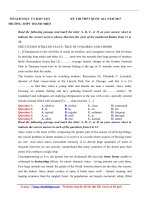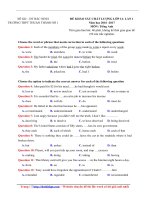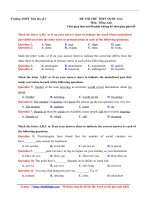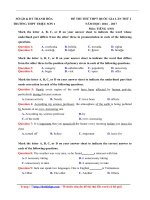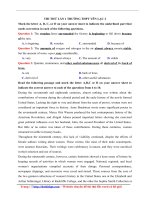THPT chuyen Dai hoc su pham Ha Noi mon Tieng Anh Lan 1 nam 2017 File word co loi giai MIEN PHI
Bạn đang xem bản rút gọn của tài liệu. Xem và tải ngay bản đầy đủ của tài liệu tại đây (196.52 KB, 10 trang )
<span class='text_page_counter'>(1)</span>BỘ GIÁO DỤC VÀ ĐÀO TẠO TRƯỜNG ĐẠI HỌC SƯ PHẠM HÀ NỘI. KỲ THI CHUẨN BỊ CHO KÌ THI THPT QUỐC GIA THÁNG 01/2017 Môn thi: Tiếng Anh Thời gian làm bài: 60 phút, không kể thời gian phát đề. (Đề thi có 06 trang) Mã đề 341 Read the following passage anh mark the letter A, B, C or D on your answer sheet to indicate the correct answer to each of the questions from 1 to 7. Under certain circumstances, the human body must cope with gases at greater-thannormal atmospheric pressure. For example, gas pressures increase rapidly during a drive made with scuba gear because the breathing equipment allows divers to stay underwater longer and dive deeper. The pressure exerted on the human body increases by 1 atmosphere for every 10 meters of depth on seater, so thay at 39 meters in seawater a diver is exposed to pressure of about 4 atmosphere. The pressure of the gases being breathed must equal the external pressure applied to the body, otherwise breathing is very difficult. Therefore all of the gases in the air breathed by a scuba diver at 40 meter are present at five times their usual pressure. Nitrogen, which composes 80 percent of the air we breathe, usually causes a balmy feeling of wellbeing at this pressure. At a depth of 5 atmosphere, nitrogen causes symptoms resembling alcohol intoxication, known as nitrogen narcosis. Nitrogen narcosis apparently results from a direct effect on the brain of the large amounts of nitrogen dissolved in the blood. Deep dives are less dangerous if helium is substituted for nitrogen, because under these pressures helium does not exert a similar narcotic effect. As a scuba diver descends, the pressure of nitrogen on the lungs increases. Nitrogen then diffuses from the lungs to the blood, and from the blood to body tissues. The reverse occurs when the diver surfaces, the nitrogen pressure in the lungs falls and the nitrogen diffuses from the tissues into the blood, and from the blood into the lungs. If the return to the surface is too rapid, nitrogen in the tissues and blood cannot diffuse out rapidly enough and nitrogen bubbles are formed. They can cause severe pains, particularly around the joints. Another complication may result if the breath is held during ascent. During ascent from a depth of 10 meters, the volume of air in the lungs will double because the air pressure at the surface is only half of what it was at 10 meters. This change in volume may cause the lungs to distend ang even rupture. This the rise of the exhaled air bubbles, and must exhale during ascent. Question 1: The word “exert” in bold on paragraph 1 is closest in meaning to ________. A. permit B. cause C. need D. change Question 2: What does the passage mainly discuss? A. The equipment divers use B. How to prepare for a deep dive C. The symptoms of nitrogen bubbles in the bloodstream 164951.
<span class='text_page_counter'>(2)</span> D. The effect of pressure on gases in the human body. Question 3: The word “they” in bold on paragraph 2 refers to ________. A. joints B. pains C. tissues D. bubbles Question 4: What happens to nitrogen in body tissues if a diver ascends too quickly? A. It is reabsorbed by the lungs B. It goes directly to the brain C. It forms bubbles D. It has a narcotic effect Question 5: It can be inferred from the passage that which of the following presents the greatest danger to a diver? A. Nitrogen diffusion B. An air embolism C. Nitrogen bubbles D. Pressurized helium Question 6: The word “rupture” in bold in paragraph 3 is closest in meaning to ________. A. shrink B. burst C. hurt D. stop. BỘ ĐỀ THI THỬ, TÀI LIỆU THPT QUỐC GIA NĂM 2017 MỚI NHẤT FILE WORD Bên mình đang có bộ đề thi thử THPTQG năm 2017 mới nhất từ các trường , các nguồn biên soạn uy tín nhất. . 200 – 250 đề thi thử cập nhật liên tục mới nhất đặc sắc nhất năm 2017. Theo cấu trúc mới nhất của Bộ giáo dục và đào tạo (50 câu trắc nghiệm). 100% file Word (.doc) có thể chỉnh sửa, biên tập. 100% có đáp án & lời giải chi tiết từng câu. Nhiều tài liệu hay khác : Đề theo chuyên đề, sách tham khảo, tài liệu file word tham khảo hay khác….. HƯỚNG DẪN ĐĂNG KÝ Soạn tin nhắn: “Tôi muốn đặt mua bộ đề thi, tài liệu TIẾNG ANH 2017”. rồi gửi đến số 0983.26.99.22 (Mr. Dương) Sau khi nhận được tin nhắn chúng tôi sẽ liên hệ với bạn để hướng dẫn các xem thử và cách đăng ký đặt mua. Uy tín và chất lượng hàng đầu chắc chắn bạn sẽ hài lòng. Question 14: “Why don’t you choose German as your optional subject?” said Jane. A. Jane admitted that I chose German as my optional subject. B. Jane suggested that I choose German as my optional subject. C. Jane reminded me of choosing German as my optional subject. D. Jane suggested choosing German as my optional subject..
<span class='text_page_counter'>(3)</span> Read the following passage and mark the letter A, B, C or D on your answer sheet to indicate the correct word or phrase that best fits each of the numbered from 15 to 19. Fashions go round and round Fashions have always changed with time. No (15) ________ Roman girls worried about having the latest hairstyle and boys in Ancient Egypt wanted to have sandals that were cool and not the sensible ones their mothers preferred. Look (16) ________over recent times, there seem to be two main differences in the way fashions have changed compared to earlier time. Firstly, (17) ________ more people have a choice of clothes available to them. There are few places in the world where the trainers, the caps or the T-shirts of teenagers do not change from one year to the next. Secondly, styles are (18) ________within a much shorter time than they used to be. For instance, in the 1960s, (19) ________ had the same low waists and narrow skirts as forty years before. In the early years of the 21st century, the shops are full of long skirts and colored scarves like the ones in fashion only thirty years before. Soon, we will find that the really fashionable people look no different from the rest of us, because it is only ten years since their clothes were in fashion before! Question 15. A. way B. doubt C. chance D. matter Question 16. A. about B. round C. behind D. back Question 17. A. far B. some C. even D. much Question 18. A. exchanged B. returned C. repeated D. accepted Question 19. A. jackets B. blouses C. trousers D. dresses 164984 Mark the letter A, B, C or D on your answer sheet to indicate the underlined part that needs correction in each of the following questions. Question 20. A smile can be observed, described, and reliably identify, it can also be elicited and manipulated under experimental conditions. A. identify B. experimental C. can also D. A smile Question 21. A food additive is any chemical that food manufacturers intentional add to their products. A. products B. intentional C. any chemical D. additive Question 22. A number of the American Indian languages spoken at the time of the European arrival in the New World in the late fifteen century have become extinct. A. spoken B. fifteen C. at the time D. A number of 164991 Read the following passage and mark the letter A, B, C, D on your answer sheet ti indicate the correct answer to each of the question from 23 to 30 There are a number of natural disasters that can strike across the globe. Two that are frequently linked to one another are earthquakes and tsunamis. Both of them can cause a great amount of devastation when they hit. However, tsunamis are the direct result of earthquakes and cannot happen without them. The Earth has three main parts. They are the crust, the mantle, and the core. The crust is the outer layer of the Earth. It is not a single piece of land. Instead, it is comprised of a 164974.
<span class='text_page_counter'>(4)</span> number of plates. There are a few enormous plates and many smaller ones. These plates essentially rest upon the mantle, which is fluid. As a result, the plates are in constant - yet slow - motion. The plates may move away from or toward other plates. In some cases, they collide violently with the plates adjoining them. The movement of the plates causes tension in the rock. Over a long time, this tension may build up. When it is released, an earthquake happens. Tens of thousands of earthquakes happen every year. The vast majority are so small that only scientific instruments can perceive them. Others are powerful enough that people can feel them, yet they cause little harm or damage. More powerful earthquakes, however, can cause buildings, bridges, and other structures to collapse. They may additionally injure and kill thousands of people and might even cause the land to change its appearance. Since most of the Earth’s surface is water, numerous earthquakes happen beneath the planet’s oceans. Underwater earthquakes can cause the seafloor to move. This results in the displacement of water in the ocean . When this occurs , a tsunami may form. This is a wave that forms on the surface and moves in all directions from the place where the earthquake happened. A tsunami moves extremely quickly and can travel thousands of kilometres. As it approaches land, the water near the coast gets sucked out to sea. This causes the tsunami to increase in height. Minutes later, the tsunami arrives. A large tsunami - one more than ten meters in height- can travel far inland. As it does that, it can flood the land, destroy human settlements, and kill large numbers of people. Question 23: Which of the following statements does paragraph 1 support? A. A tsunami happens in tandem with an earthquake. B. The most severe type of nature disaster is an earthquake. C. Earthquakes cause more destruction than tsunamis. D. Earthquakes frequently take place after tsunamis. Question 24. The word “it” in bold in paragraph 2 refers to ________. A. The core B. The crust C. The earth D. The mantle Question 25: What is the passage mainly about? A. When earthquakes are the most likely to happen B. What kind of damage natural disasters can cause C. How earthquakes and tsunami occur D. Why tsunamis are deadlier than earthquakes Question 26: The word “adjoining” in bold in paragraph 2 is closest in meaning to ________. A. Residing B. Approaching C. Bordering D. Appearing Question 27: The word “perceive” in bold in paragraph 3 is closest in meaning to ________. A. Detect B. Prevent C. Comprehend D. Locate Question 28: Which of the following is true regarding the ? A. It is the smallest of the Earth’s three layers B. It is thicker on land than it is under the water crust.
<span class='text_page_counter'>(5)</span> C. There are many separate pieces that make it up D. The mantle beneath it keeps it from moving too much Question 29: Based on the passage, what is probably true about tsunamis? A. They kill more people each year than earthquakes B. They are able to move as fast as the speed of the sound C. They can damage ships sailing on the ocean D. They can be deadly to people standing near the shore Question 30: Which of the following is NOT mentioned in paragraph 3 about earthquakes? A. How severe the majority of them are B. What kind of damage they can cause C. How often powerful ones take place D. How many people they typically kill. 165002 Mark the letter A, B, C, or D on your answer sheet to indicate the word whose underlined part differs from the other three in pronunciation in each of the following questions. Question 31. A. nowadays B. dykes C. ruins D. pesticides Question 32: A. opposite B. economic C. appropriate D. technology 165005 Mark the letter A, B, C, or D on your answer sheet to indicate the most suitable response to complete each of the following exchanges. Question 33: Is it all right if I use your bike? A. Please accept it with my best wishes. B. Go straight ahead C. Sure, go ahead D. Oh, sorry Question 34: What do you think about the election? A. I must be off. Thank you B. The Democratic Party had to win C. Really? The Republican Party won D. The Democratic should have won 165008 Mark the letter A, B, C, or D on your answer sheet to indicate the sentence that best combines each pair of sentences in the following questions. Question 35: The leader went so fast that no one could keep up with him. A. If only the leader had gone faster. B. What a fast leader! C. If the leader hadn’t gone so fast, we could have kept up with him. D. I wish the leader could not have kept up with us. Question 36. Mary lost the ticket. She didn’t go to the concert. A. If Mary had lost the ticket, she would have gone to the concert. B. Had Mary not lost the ticket, she would have gone to the concert. C. Hadn’t Mary lost the ticket, she would have gone to the concert. D. If Mary hadn’t lost the ticket, she would go to the concert. 165011 Mark the letter A, B, C, or D on your answer sheet to indicate the word(s) CLOSEST in meaning to the underlined word(s) in each of the following questions. Question 37: A magician is an entertainer who performs a series of deceptive tricks based on the principles of physics, optics, and psychology. A. skillful B. incomprehensible C. misleading D. obvious.
<span class='text_page_counter'>(6)</span> Question 38: The adhesive qualities of this new substance far surpass those of all other of its type. A. disintegrating B. dissolving C. damaging D. sticky 165014 Mark the letter A, B, C, or D on your answer sheet to indicate the correct answer to each of the following questions.. BỘ ĐỀ THI THỬ, TÀI LIỆU THPT QUỐC GIA NĂM 2017 MỚI NHẤT FILE WORD Bên mình đang có bộ đề thi thử THPTQG năm 2017 mới nhất từ các trường , các nguồn biên soạn uy tín nhất. . 200 – 250 đề thi thử cập nhật liên tục mới nhất đặc sắc nhất năm 2017. Theo cấu trúc mới nhất của Bộ giáo dục và đào tạo (50 câu trắc nghiệm). 100% file Word (.doc) có thể chỉnh sửa, biên tập. 100% có đáp án & lời giải chi tiết từng câu. Nhiều tài liệu hay khác : Đề theo chuyên đề, sách tham khảo, tài liệu file word tham khảo hay khác….. HƯỚNG DẪN ĐĂNG KÝ Soạn tin nhắn: “Tôi muốn đặt mua bộ đề thi, tài liệu TIẾNG ANH 2017”. rồi gửi đến số 0983.26.99.22 (Mr. Dương) Sau khi nhận được tin nhắn chúng tôi sẽ liên hệ với bạn để hướng dẫn các xem thử và cách đăng ký đặt mua. Uy tín và chất lượng hàng đầu chắc chắn bạn sẽ hài lòng. THE END.
<span class='text_page_counter'>(7)</span> HƯỚNG DẪN GIẢI CHI TIẾT Thực hiện: Ban Chuyên môn Tuyensinh247.com 1. B. 2. D. 3. B. 4. B. 5. A. 6. D. 7. D. 8. B. 9. C. 10. D. 11. D. 12. A. 13. A. 14. C. 15. C. 16. C. 17. B. 18. B. 19. D. 20. B. 21. B. 22. B. 23. C. 24. C. 25. C. 26. B. 27. B. 28. C. 29. B. 30. A. 31. D. 32. C. 33. A. 34. C. 35. B. 36. D. 37. C. 38. C. 39. D. 40. A. 41. B 42. D 43. D 44. D 45. C 46. A 47. A 48. C 49. B 50. C 1. B Từ “exert” được in đậm ở đoạn 1 gần nghĩa nhất với Permit: Cho phép Cause: Gây ra Need: cần Change: Thay đổi “Những thợ lặn sâu thường ít nguy hiểm hơn nếu khi Heli được thay thế cho khí Ni tơ, bởi vì dưới áp lực, khi ni tơ không gây ra (exert hoặc cause) tác dụng gây mê tương tự.” => Cause 2. D Bài đọc chủ yếu thảo luận về vấn đề gì? The equipment divers use: Thiết bị mà thợ lặn sử dụng How to prepare for a deep dive: Cách chuẩn bị cho một chuyến lặn sâu The symptoms of nitrogen bubbles in the bloodstream: Dấu hiệu khi bóng Ni tơ ở trong dòng chảy của máu. The effects of pressure on gases in the human body: Tác động của áp lực lên không khí trong cơ thể con người. => The effects of pressure on gases in the human body. 3. D Từ “they” được in đậm ở đoạn 2 ám chỉ đến Joints: Các khớp xương Pains: Cơn đau Tissues: Các mô Bubbles: Bong bóng Nếu như quay trở lại mặt nước quá nhanh, khí ni tơ trong các mô và máu không thể khuếch tán ra ngoài đủ nhanh chóng và bóng khí ni tơ sẽ hình thành. Bóng khí ni tơ sẽ gây ra những cơn đau khủng khiếp, đặc biệt là xung quanh các khớp xương. 4. C Điều gì xảy ra với ni-tơ trong tế bào cơ thể nếu một thợ lặn giảm quá nhanh? It is reabsorbed by the lungs: Chúng được phổi hấp thụ lại It goes directly to the brain: Chúng đi thẳng vào não It forms bubbles: Chúng tạo thành bóng khí It has narcotic effect: Chúng có tác động gây mê Đoạn thứ 2, dòng thứ 4. “If the return to the surface is too rapid, nitrogen in the tissues and blood cannot diffuse out rapidly enough and nitrogen bubbles are formed.” (Nếu như quay trở lại mặt nước quá nhanh, khí ni tơ trong các mô và máu không thể khuếch tan ra ngoài đủ nhanh chóng và bóng khí ni tơ sẽ hình thành.) 5. B.
<span class='text_page_counter'>(8)</span> Có thể suy ra từ bài đọc rằng điều gì là mối nguy hiểm lớn nhất đối với thợ lặn? Nitrogen diffusion: Sự khuếch tán khí Ni tơ An air embolism: Sự thuyên tắc hơi Nitrogen bubbles: Bóng khí Ni tơ Pressurized helium: Khí Heli nén Đoạn cuối, dòng thứ nhất. “During ascent from a depth of 10 meters, the volume of air in the lung will double because the air pressure at the surface is only half of what it was at 10 meters. This change in volume may cause the lungs to distend and even rupture. This condition is called air embolism.” (Trong quá trình nồi lên từ độ sâu 10 mét, lượng không khí trong phổi sẽ tăng lên gấp đôi vì áp lực khí tại bề mặt nước chỉ còn 1 nửa so với ở độ sâu 10 mét. Sự thay đổi về lượng khí có thể làm phổi sưng phồng, thậm chí là vỡ nát. Hiện tượng này gọi là thuyên tắc hơi.) => An air embolism. 6. B Từ “ rupute” được in đậm ở đoạn 3 gần nghĩa nhất với Shrink: co lại Burst: vỡ, nổ, bục ra Hurt: đau Stop: dừng lại Rupture (vỡ nát) = Burst => Burst 7. D Một thợ lặn nên làm gì khi trồi lên mặt nước? Breathe helium: Thở khí Heli Relax completely: Hoàn toàn thư giãn Breathe faster: Thở nhanh hơn Rise slowly: Nổi lên một cách từ từ Đoạn cuối cùng, câu cuối cùng: “To avoid this event, a diver must ascend slowly,..(Để tranh hiện tượng này, thợ lặn phải nổi lên thật chậm...) => Rise slowly 8. D government /ˈɡʌvənmənt/ interview /ˈɪntəvjuː/ reference /ˈrefrəns/ understand /ˌʌndəˈstænd/ => Câu D trọng âm 3 còn lại trọng âm 1 => Chọn D 9. B equipment /ɪˈkwɪpmənt/ scholarship /ˈskɒləʃɪp/ develop /dɪˈveləp/ discourage /dɪsˈkʌrɪdʒ/ =>Câu B trọng âm 1 còn lại trọng âm 2 => Chọn B 10. A Subordinates (n): nhân viên cấp dưới Bosses: ông chủ, sếp Coordinators: điều phối viên Outside help: lực lượng giúp đỡ bên ngoài Employees: nhân viên Câu này dịch như sau: Một ông chủ phải rất cẩn thận trong việc giải quyết vấn đề với cấp dưới và thu thập tài liệu về đời sống của họ để tránh những lời phàn nàn. =>Subordinates >< Bosses => Chọn A 11. D Incomprehensible (adj): khó giải thích, không thể hiểu được.
<span class='text_page_counter'>(9)</span> Readable: có thể đọc được Favorable: được ưa chuộng Imperative: bắt buộc Understandable: dễ hiểu =>Incomprehensible >< Understandable => Chọn D 12. D Câu này dịch như sau: Đáng lẽ ra tôi nên hoàn thành công việc vào tối qua nhưng tôi mệt quá. A. Tối qua tôi mệt nhưng tôi đã cố gắng hoàn thành công việc. B. Công việc của tôi đã được hoàn thành tối qua nhưng tôi rất mệt. C. Tôi đã hoàn thành công việc tối qua mặc dù tôi rất mệt. D. Tôi rất mệt vì vậy tôi đã không hoàn thành công việc hôm qua như dự định. =>Chọn D Cấu trúc: S+ should have Ved: đáng lẽ ra nên làm gì (nhưng đã không làm). BỘ ĐỀ THI THỬ, TÀI LIỆU THPT QUỐC GIA NĂM 2017 MỚI NHẤT FILE WORD Bên mình đang có bộ đề thi thử THPTQG năm 2017 mới nhất từ các trường , các nguồn biên soạn uy tín nhất. . 200 – 250 đề thi thử cập nhật liên tục mới nhất đặc sắc nhất năm 2017. Theo cấu trúc mới nhất của Bộ giáo dục và đào tạo (50 câu trắc nghiệm). 100% file Word (.doc) có thể chỉnh sửa, biên tập. 100% có đáp án & lời giải chi tiết từng câu. Nhiều tài liệu hay khác : Đề theo chuyên đề, sách tham khảo, tài liệu file word tham khảo hay khác….. HƯỚNG DẪN ĐĂNG KÝ Soạn tin nhắn: “Tôi muốn đặt mua bộ đề thi, tài liệu TIẾNG ANH 2017”. rồi gửi đến số 0983.26.99.22 (Mr. Dương) Sau khi nhận được tin nhắn chúng tôi sẽ liên hệ với bạn để hướng dẫn các xem thử và cách đăng ký đặt mua. Uy tín và chất lượng hàng đầu chắc chắn bạn sẽ hài lòng. 48. A Câu này dịch như sau: Bao nhiêu người tham gia vào trò chơi thì vẫn chưa biết. Câu có động từ chính là “is” => cả mệnh đề phía trước động vai trò chủ ngữ : how many +S+V.
<span class='text_page_counter'>(10)</span> => Chọn A 49. C Câu này dịch như sau: Chuyến xe buýt thứ 2, cái mà đã đầy hành khách, cũng không dừng lại. Cấu trúc mệnh đề quan hệ dung which thay cho danh từ chỉ vật đứng trước (the second bus) và có số thứ tự nên dùng dấu phẩy. => Chọn C 50. C Câu này dịch như sau: Tôi đã đứng đây hàng giờ và tôi cảm thấy rất mệt. Để diễn tả sự việc xảy ra từ quá khứ và kéo dài cho đến hiện tại [có for] nên dùng thì hiện tại hoàn thành tiếp diễn để nhấn mạnh tính chất liên tục của hành động. S+ have/ has been + Ving => Chọn C. Eroguseriotv ueriobyjserotvjerm90buyjmuu6490uitv523490k34icr04itv90utcrik3490tvukci3vikc-0ewiltv-0itvktcrl234ict34tvbkyeyhserhasegh. Eroguseriotv ueriobyjserotvjerm90buyjmuu6490uitv523490k34icr04itv90utcrik3490tvukci3vikc-0ewiltv-0itvktcrl234ict34tvbkyeyhserhasegh.
<span class='text_page_counter'>(11)</span>


